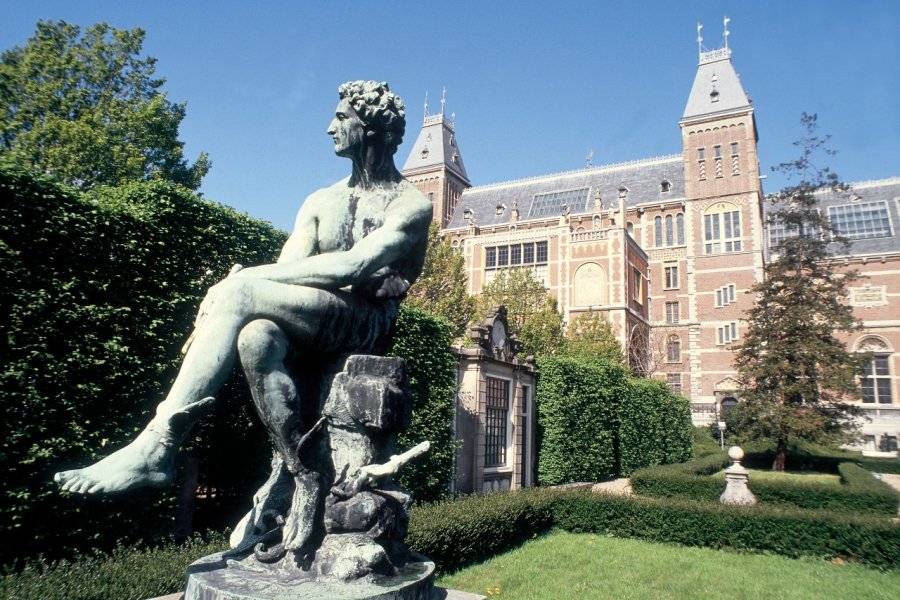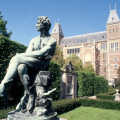Magnificent museum of the city, its visit is an enchantment. You will admire Rembrandt, Vermeer, Hals in a majestic setting.
The Rijksmuseum (pronounced [Raïksmuséum]) is truly Amsterdam's cultural jewel, both for its unrivalled collection and for the splendour of its restored architecture. After more than ten years of painstaking work, this cultural landmark of the Netherlands reopened in April 2013, in a ceremony presided over by Queen Beatrix, marking one of her last public appearances as sovereign. Sometimes referred to as the "true history museum of the Netherlands", this museum alone is well worth a visit to Amsterdam. To take full advantage of its riches, we recommend spending at least four hours, if not a whole day, at the Rijksmuseum.
The Rijksmuseum offers a fascinating journey through Dutch history and art, from the Middle Ages to the 20th century, in an international setting. The collection, which spans four floors, comprises over 8,000 works, including paintings, drawings and prints, as well as historical objects such as silverware, Delft porcelain, furniture and various artifacts. This diversity offers a total immersion in beauty and cultural heritage, in a magnificently restored setting. Indeed, renovation work has revealed splendidly ornate ceilings, adding to the splendor of the place, placing it among the world's greatest museums. Temporary exhibitions complete the visit, which is already rich in monumental works.
Middle Ages and Renaissance (1100-1600): Superb, dark-walled rooms featuring paintings and various objects, including Jan van Scorel, Maria Magdalena, circa 1530; Mater Dolorosa, circa 1500-1510; Les Pleurants, ten bronze figures.
The Golden Age (1600-1700): more than 30 rooms are devoted to this period of total expansion in the Netherlands. The highlight of this section is the Galerie d'Honneur, featuring works by Frans Hals, Jan Steen, Johannes Vermeer and Rembrandt. The final room is devoted to Rembrandt's Night Watch, which has been undergoing restoration since 2019 (a project dubbed Operation Night Watch, requiring some 30 specialists and costing several million euros).
AT not to be missed: Rembrandt van Rijn, Night Watch, 1642; Rembrandt van Rijn, The Jewish Bride, c. 1665-1669; Johannes Vermeer, The Milkmaid, 1660; Johannes Vermeer, Woman in Blue Reading a Letter, c. 1663; Gerrit Berckheyde, The Golden Curve in the Herengracht, 1671; Jan Steen, The Mayor of Delft and his Daughter, 1655; Frans Hals, Portrait of Isaac Massa and Beatrix van der Laan, c. 1622; Dollhouses by Petronella Oortman, c. 1686-1710.
18thcentury (1700-1800). The Netherlands was no longer a strong nation, and the money earned was transformed into housing. In the 18th century, home interiors were of paramount importance. This period is distinguished by its refinement and the development of good taste. Don't miss L' Amour menaçant, Étienne-Maurice Falconet (commissioned by Madame de Pompadour), 1757; De Beuningkamer, stylish mahogany room from a patrician house, 1748; Jean-Étienne Liotard, Portrait de Marie Fargues, 1765-1768.
19th century (1800-1900). The beginning of royalty and a period that saw major scientific discoveries, it is symbolized by great modernization. Don't miss Jan Willem Pieneman, Waterloo, 1824; Cassette with pistols of Napoleon, c. 1813-1815; Vincent van Gogh, Self-portrait, 1887; George Breitner, Girl with white kimono, 1894.
20th century (1900-2000). A completely new presentation for this century, with furniture, paintings, photographs, posters, films, historical objects and numerous loans from other museums, providing a portrait of the cultural and artistic history of the modern Netherlands in the last century. Don't miss: Gerrit Rietveld, Fauteuil blanc, 1923; Piet Mondriaan, Trafalgar Square, 1942; Frits Koolhoven, Dubbeldekker F.K.23, named 'Bantam', 1917; Karel Appel, De vierkante man, 1951; Le Corbusier, Maquette du pavillon Philips, pour l'Exposition universelle de Bruxelles, 1958.
Asian art. This collection is presented in a new pavilion designed by architects Cruz and Ortiz, all in concrete and surrounded by water. The two-storey building is filled with reflection, magic, beauty and wonder. A variety of objects from China, Japan, Indonesia, India, Vietnam and Thailand are on display. Objects (from 2000 BC to 2000) are presented by country.
The Cuypers Library. This is the oldest art library in the Netherlands, and has been extensively restored. The superb reading room is clearly visible and a must-see.
Special collections. The museum also boasts special collections of silverware, musical instruments, various relics, weapons and miniature boats, all sublimely presented.
Miscellaneous collections, fashion, photos, drawings. The museum shows part of its very rich collection with a presentation that changes regularly. Costumes, for example, change every six months.
A brief history of the Rijksmuseum. The Rijksmuseum opened its doors as a national gallery in 1800. At the time, it was located at the Huis ten Bosch in The Hague. Its collection consisted mainly of paintings and historical objects. The museum moved to Amsterdam in 1808, on Napoleon's orders, to the Royal Palace on Dam Square. Napoleon wanted Amsterdam to become a leading cultural and artistic center. In 1816, William I moved the museum to the Trippenhuis, a sort of Venetian palace built by two merchant brothers in the Kloveniersbugwal, and renamed it the Rijksmuseum. The current building opened in 1885, incorporating the collections of The Hague Museum of History and Art.
Cuypers Cathedral. The need for a truly national museum became apparent, and construction began in 1876 after lengthy negotiations. The architect, Pierre Cuypers (1827-1921), created a brick building blending Gothic and Renaissance styles. The official inauguration took place on July 13, 1885. The collection brought together the paintings and prints of the Trippenhuis, as well as all the paintings of the city of Amsterdam, notably the famous Rembrandts. The 19th-century collection from Haarlem was added to the museum, as was a large part of the Cabinet of Curiosities, which had been integrated into the National Museum of History and Art.
Renovations. As the museum's collections grew ever larger, space was quickly at a premium and a number of extensions were carried out over the years. Between 1904 and 1916, rooms were added on the south side (now the Philips wing) to display the painting collections bequeathed by the Drucker-Fraser couple. Interior courtyards were added in the 1950s and 1960s to enlarge the display space. The 1950s also saw the birth of the Asian collection, following the integration of the collection of the Association des amis des arts asiatiques.
The 1970s saw a surge in visitor numbers, underlining the need for modern standards. This need was increasingly felt until the 1990s, making renovations inevitable, which were completed (in full) in 2015, following the grand reopening of 2013.
In 2025, from February 7 to June 9, a major exhibition entitled American Photography will take place. It features no fewer than 200 photographs by both anonymous and famous artists. These include Sally Mann, Irving Penn, Robert Frank, Lisette Model and Nan Goldin. The collection traces the history of photography in the United States, from personal moments in everyday life to turning points in history. It also reveals how photography has permeated every aspect of our lives - including art, news, advertising and the private sphere - since its invention in the 19th century.
Until March 23, 2025, an exhibition dedicated to lingerie from the seventeenth to the twentieth century, covering its evolution from 1640 to around 1940. Initially functional, lingerie became a fashion statement over the years.
Did you know? This review was written by our professional authors.
Members' reviews on RIJKSMUSEUM
The ratings and reviews below reflect the subjective opinions of members and not the opinion of The Little Witty.












Daarna een lekkere "afterdrink" in het restaurant met een heel vriendelijke staf!
Kortom, 5 sterren!